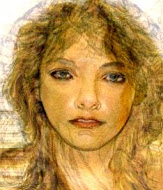Also called Garden Sage, Red Sage, Sawge (Old English), Salvia salvatrix, Narrow-leaved White Sage, Broad-leaved White Sage Sage is a perennial herb with grayish-green leaves that are slightly hairy. It is native to Spain and the Mediterranean coast, and is a member of the Salvia family. It is a variable species, and it's flowers can be blue, pink, or white. It can be grown in containers and makes a nice container specimen. While sage has links to many cultures throughout the world, it is thought to have originated in Syria. From there it spread throughout the northern Mediterranean and then on to the rest of the world via the trade routes. With over 500 species, from colored varieties to dwarfs to non - flowering varieties, sage is grown throughout the world (almost anywhere there is good drainage and full sun). Most of the varieties are perennials, fast growers, require low moisture and are deer resistant, making them a favorite with gardeners and cooks Sage can be used fresh, dried, or chopped and frozen in ice cube trays. It has a lemony, camphor-like, and slightly bitter taste and it is a very aromatic herb.
For thousands of years sage has been used for a variety of culinary and medicinal purposes, and over the past 2,000 years or so has been recommended by herbalists to treat just about every known condition, from snakebite to mental illness. In fact, in medieval times the French called the herb toute bonne, which means, "all is well". It has been used in connection with sprains, swelling, ulcers, and bleeding. As a tea, sage has been administered for sore throats and coughs. Herbalists have also used this herb for rheumatism, menstrual bleeding, strengthening the nervous system, improving memory, and sharpening the senses. Even today, in many European countries sage is used medicinally as a gargle for sore throat and inflammation of the mouth and gums. Clinical studies also indicate that the substance found in sage oil may also offer antibacterial, anti-fungal, and antiviral effects, explaining much of its medicinal activity. In Germany, sage herb is commonly used for upset stomach and excessive sweating, and one German study has found that drinking a sage infusion reduced blood sugar levels in people with diabetes, but only when they took the infusion on an empty stomach. In England, sage is used for some symptoms of menopause. Sage has traditionally been used to promote menstruation, and there are some studies that indicate it may indeed help stimulate uterine contractions; pregnant women should not consume highly concentrated forms of sage, although using it as a culinary spice has not been shown to have this effect. Recent laboratory studies support the use of sage to guard against infection-it has demonstrated an ability to fight against several infection-causing bacteria. As far back as ancient Greek and Roman times, healers advocated sage for a variety of ailments. Charlemagne ordered that it be grown in his royal gardens. Arab physicians in the 10th century went so far as to claim that sage extended life to the point of immortality. Even the genus name of the plant, Salvia, comes from the Latin meaning "to cure."
For sore throats, try mixing a Sage tea with apple cider vinegar and salt for gargling. Sage is reported to have moisture-drying properties, and can be used as an antiperspirant. It can also be used as a compress on cuts and wounds. Clinical studies have also shown that it can lower blood sugar in cases of diabetes. Try making capsules out of dried leaves as a substitute for teas for internal use. As an astringent, Sage can be used as a refreshing after-shave, and there is some indication that an infusion of it can be used to subtly color silver hair. As with many of the other herbs, Sage can also be tried in a tea for digestive problems and flatulence.
In an exciting new study done in 2003, English scientists at Newcastle and Northumbria found that Sage oil extracts in capsule form produced markedly improved memory function in test subjects, and it is very possible that Sage may protect a key chemical destroyed in the brain by Alzheimer's disease. Better yet, no side effects whatsoever were reported by participants. Although studies are not complete at this time, this is very promising research and should be followed by anyone who has or is caring for someone with Alzheimer's. Like two other culinary herbs, rosemary and thyme, sage helps guard against depletion of the brain's concentration of acetylcholine, a neurotransmitter that is crucial to proper brain function. A combination of ginkgo biloba, sage, and rosemary may help prevent or slow the development of Alzheimer's.
Very few side effects have been reported from the consumption of sage leaves; however, those using more concentrated forms of this herb, such as tea or extracts, may experience inflammation of the lips and lining of the mouth. This inflammatory response is probably due to a toxic chemical in sage called thujone. In very large amounts, thujone has been shown to cause convulsions. Concentrated sage oil is toxic and its use should be restricted to aromatherapy. Incidentally, you will often see Sage medicines advertised as Clary Sage. This is just another form of Sage that originates in the Mediterranean but has the same medicinal properties as the other sages.
Sage's usefulness goes beyond the confines of the medicine cabinet and the kitchen. Because of its aromatic oils, it is frequently used in making soaps and perfumes. Native Americans utilize sage for spiritual purification ceremonies in the form of smudge sticks. These are branches of white sage (Salvia apiana) which have been cut into lengths about one foot long, bound together and dried. For the ceremony, they are lit and left to smolder, producing a rich, aromatic smoke.
Purification, Cleansing Sage is used in magic for wisdom, psychic awareness, long life and protection. As secondary aspects, spells for money use sage. But, by far, its most potent aspect is wisdom and learning. Sage is often bundled tightly into smudge sticks and burned as a scent. Sage was associated with immortality and longevity by the ancients. It was also credited with increasing mental capacity. Eat the fresh leaves (in moderation) for both these purposes. Today, Sage is believed to be a purifier and a healing herb. It can be made into a tea to promote healing, and can be burned to rid a room of negative energy.
Sage is bound to Jupiter and Air. It is believed that if you place some Sage (or burn it) near an object belonging to someone in need of healing, that healing will take place more quickly. It is also said that the condition of the Sage plant itself in your garden is an indication of your prosperity. Sage is useful in magic relating to immortality, longevity, wisdom, protection, prosperity. White sage leaves are widely used as a cleansing herb, to purify the mind, body and also to purify the atmosphere & to dispel negativity. It is also used to purify sacred items. Often carried in a charm bag or even a pocket to ensure personal and spiritual safety. It is said that those who eat sage become immortal in both wisdom and years. Sage is used in wish manifestations and to attract money. Smolder to promote healing and spirituality. Use in healing and money spells. Use as incense during sacred rituals -- walk the smoke to the four corners of the room to repel and rid negative energies and influences. Especially good when moving into a new home. Heals wounds, aids digestion, eases muscle and joint pain, colds and fever.
To burn the sage -- just place a small amount in a heat proof container into which you have put a charcoal disc light it, then direct the smoke around your body and the space you wish to cleanse You can also use a "smudging feather" or your hand to direct the smoke. You could even have ago at making your own smudge sticks. Which are easy to do and very rewarding to make. Never leave lit smudge unattended and care should be used when extinguishing and disposing of the ashes.
Sources:
Joelle's Sacred Grove
Alchemy Works
Sally's Place
The Magick Moon
Vitaminstuff
Disclaimer: No one involved in this blog or its contents may be held responsible for any adverse reactions arising from following any of the instructions/recipes on this list. It is the reader's personal responsibility to exercise all precautions and use his or her own discretion if following any instructions or advice from this blog.
GoPuff: Free Premier Protein Drinks on Jan 5-9
6 hours ago















No comments:
Post a Comment